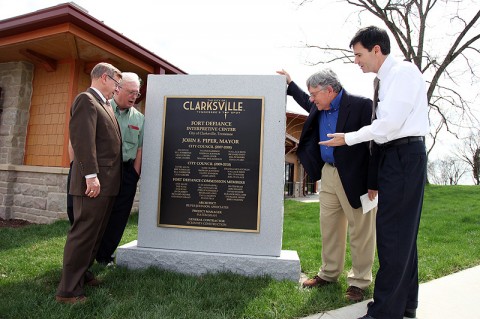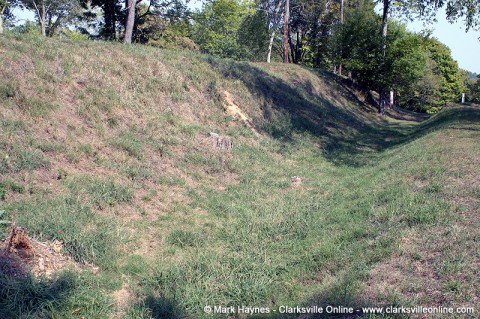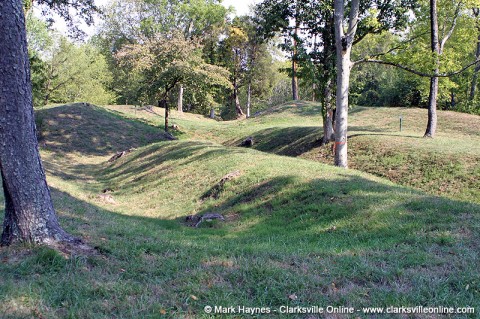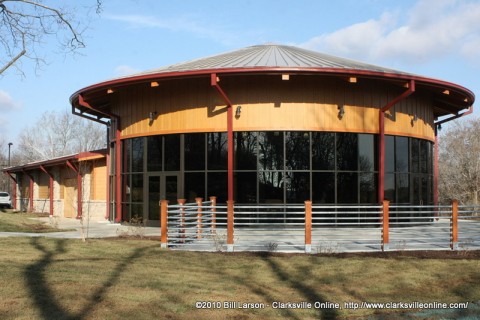 Clarksville, TN – In 1982, two young Austin Peay State University history professors – Dr. Howard Winn and Dr. Richard Gildrie – ventured up to the top of a forgotten hill overlooking the Cumberland River. What they found was a wild tangle of bushes and sapling trees, 10 to 12 feet tall, that blocked out the sun and made it nearly impossible to hike through without machetes and axes.
Clarksville, TN – In 1982, two young Austin Peay State University history professors – Dr. Howard Winn and Dr. Richard Gildrie – ventured up to the top of a forgotten hill overlooking the Cumberland River. What they found was a wild tangle of bushes and sapling trees, 10 to 12 feet tall, that blocked out the sun and made it nearly impossible to hike through without machetes and axes.
Judge Sam Boaz, who owned the land, had asked the two men to come take a look and see if it was historically important. Rumor had it an old Civil War fort was hidden somewhere in those weeds. The professors hacked their way into that dense mess until they found the old earthen walls and communication trenches of what was known in the early 1860s as Fort Defiance.

Dr. Philip Kemmerly, an APSU professor of geology, soon joined the project, and it was the goal of the three professors to help turn this forgotten landmark into a viable city park before they retired. They almost made it. Winn retired in 2005. Gildrie followed him three years later.
But this April, nearly 30 years after these APSU professors first visited the site, the city of Clarksville is set to open officially its new Fort Defiance Civil War Park. Winn, Gildrie, Kemmerly and Dr. David Snyder, APSU professor of history, gathered at the park last week to take a look around and reminisce about the three decades it took to see this project through.

“We said several years back that we’d like to see it open before we died,” Winn said.
“It was before we retired, and I haven’t retired yet,” Kemmerly interjected.
“Well I’ve been retired,” Winn said. “I just didn’t want to die before it opened. It feels real good to see it come to fruition.”
Resurrecting the Fort

In 1984, Boaz deeded the land containing Fort Defiance to the city of Clarksville. That’s when the real work began. The terrain was so thick and impassable; it took the professors, APSU students, volunteers and Boy Scouts about five hours to hack a short path to the fort’s entrance. And then there were the chiggers – little tick-like mites that attach themselves and chew on a person’s exposed skin.
“I came out to clean this up that first day,” Winn said. “By the time I left, I was so covered with chiggers. And then, to top that off, we brought the mayor out. Mayor (Ted) Crozier called me up that night because he got all the chiggers I didn’t have.”
Gildrie said they counted 106 chiggers on Winn while he and Kemmerly escaped with only about four or five bites. Kemmerly joined the project that summer because it became clear to the history professors that they needed someone to help them identify what was natural and what was man-made at the site.
“We figured we needed a geologist, someone who could do proper mapping,” Gildrie said. “Phil is an outstanding geologist. So he came out and so did students – some from (the APSU) geology and (the APSU) history departments. We all worked out here.”
Kemmerly and his students spent several long, hot summer afternoons clearing the land and trying to map out the environment.
“It was a lot of sweat,” he said. “The vegetation in places was 10, 12 feet tall. We literally, a couple of times, fell into some of those trenches.”
City workers even lost a bush hog in one of those trenches, Gildrie said, because they couldn’t see through all the trees how the land dipped down.
A slow process

No Civil War battle was ever fought at Fort Defiance. Clarksville fell shortly after Union soldiers took Fort Donelson up the Cumberland River in Stewart County. But the site is important because not only did it house Confederate forces and, later, occupying Union forces, but the overgrown nature of the site oddly protected it from eroding over the last 150 years.
“We had a Civil War expert come out here, and he said he thought from his experience, this was the best preserved Civil War earthen works west of the mountains,” Gildrie said. “At points, those (walls) are 7 or 8 feet high.”
The three professors over the years kept pushing for the city to do something with the fort. Eventually, then-Mayor Johnny Piper formed the Fort Defiance Commission, with Winn, Gildrie and Kemmerly being named to that board. The commission hired a grant writer and secured a $2.2 million federal grant to help connect the fort with the Riverwalk greenway. The federal government and Tennessee provided 80 percent of the grant’s funding, with the city contributing the other 20 percent of the money for this project.
In the early 2000s, the commission also received another boost with the addition of Snyder, a new history professor to APSU and a Civil War expert.
“I didn’t even appear in Clarksville until 2002,” Snyder said. “I am indeed a latecomer. These gentlemen are the real heroes of the story. They had a real vision because battle site preservation and preservation of sites like this is a big important issue today.”
Snyder lent the group a much-needed expertise on the Civil War. And Winn said he will be the one who helps keep this site relevant to future generations of historians and history buffs. The fort will also provide a perfect setting for Snyder’s classes on the Civil War.
“Absolutely, and not just the Civil War-era class we teach,” Snyder said, “but there’s also the Tennessee history class the department teaches. I’m sure we’ll make good use of this place.”
Fort Defiance Civil War Park
The new Fort Defiance Civil War Park Interpretive Center officially opens to the public on April 9th. A monument out front bears the names of Gildrie, Winn, Kemmerly and Snyder, along with other members of the committee that oversaw this project.

The area is scenic and serene, with birds chirping on this particular afternoon and the trees blossoming white and green.
“The city has done a magnificent job,” Gildrie said as he squinted into the sun.
Winn, who walks with a cane, covered his eyes with his hand and surveyed the park. Through the trees, the Cumberland River was visible down below. It might have taken almost 30 years, but Winn didn’t seem to mind. He was happy it was finally completed.
“This is what historians do,” he said. “The effort Gildrie and I were involved in out there is part of the public service role that all university professors are required to do. We teach, we do research and we do public service. Those are the three things a faculty is supposed to do. And of course Phil is a geologist, and was doing that as well. This is why you have a university in a community.”


